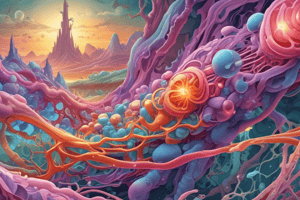Podcast
Questions and Answers
Which organelle is responsible for the synthesis of insulin in pancreatic β cells?
Which organelle is responsible for the synthesis of insulin in pancreatic β cells?
- Golgi apparatus
- Endoplasmic reticulum (correct)
- Mitochondria
- Nucleus
What is the role of C-peptide in insulin secretion?
What is the role of C-peptide in insulin secretion?
- It is equally secreted with insulin (correct)
- It is cleared by the liver and kidneys
- It is stored in secretory granules
- It is responsible for exocytosis of insulin
Which organ is involved in the clearance of insulin from the body?
Which organ is involved in the clearance of insulin from the body?
- Pancreas
- Spleen
- Liver (correct)
- Kidneys
Which molecule is equally secreted with insulin in endogenous insulin secretion?
Which molecule is equally secreted with insulin in endogenous insulin secretion?
Where is proinsulin stored before it is cleaved into insulin and C-peptide?
Where is proinsulin stored before it is cleaved into insulin and C-peptide?
Which molecule is lacking in exogenous insulin?
Which molecule is lacking in exogenous insulin?
Which tissue does insulin primarily stimulate glucose uptake into?
Which tissue does insulin primarily stimulate glucose uptake into?
Which of the following is NOT an anabolic effect of insulin?
Which of the following is NOT an anabolic effect of insulin?
Which glucose transporter is predominantly expressed in adipose tissue?
Which glucose transporter is predominantly expressed in adipose tissue?
Which glucose transporter is bidirectional and found in β islet cells and the liver?
Which glucose transporter is bidirectional and found in β islet cells and the liver?
Which organ primarily utilizes ketone bodies during starvation?
Which organ primarily utilizes ketone bodies during starvation?
Which glucose transporter is predominantly expressed in RBCs?
Which glucose transporter is predominantly expressed in RBCs?
Which glucose transporter is responsible for fructose uptake?
Which glucose transporter is responsible for fructose uptake?
Which glucose transporter is predominantly expressed in the brain and placenta?
Which glucose transporter is predominantly expressed in the brain and placenta?
Which glucose transporter is responsible for Na+-glucose cotransport in the kidney and small intestine?
Which glucose transporter is responsible for Na+-glucose cotransport in the kidney and small intestine?
Which organs/tissues are classified as BRICK LIPS?
Which organs/tissues are classified as BRICK LIPS?
Which glucose transporter is predominantly expressed in skeletal muscle and adipose tissue?
Which glucose transporter is predominantly expressed in skeletal muscle and adipose tissue?
Which glucose transporter is responsible for glucose uptake in RBCs, brain, and placenta?
Which glucose transporter is responsible for glucose uptake in RBCs, brain, and placenta?
Which glucose transporter is responsible for fructose uptake in spermatocytes and the GI tract?
Which glucose transporter is responsible for fructose uptake in spermatocytes and the GI tract?
Which glucose transporter is bidirectional and found in β islet cells and the liver?
Which glucose transporter is bidirectional and found in β islet cells and the liver?
Which organ primarily utilizes ketone bodies during starvation?
Which organ primarily utilizes ketone bodies during starvation?
Which molecule is lacking in exogenous insulin?
Which molecule is lacking in exogenous insulin?
Where is proinsulin stored before it is cleaved into insulin and C-peptide?
Where is proinsulin stored before it is cleaved into insulin and C-peptide?
Which glucose transporter is responsible for Na+-glucose cotransport in the kidney and small intestine?
Which glucose transporter is responsible for Na+-glucose cotransport in the kidney and small intestine?
What is the role of C-peptide in insulin secretion?
What is the role of C-peptide in insulin secretion?
Which organelle is responsible for the synthesis of insulin in pancreatic β cells?
Which organelle is responsible for the synthesis of insulin in pancreatic β cells?
Which molecule is the major regulator of insulin release?
Which molecule is the major regulator of insulin release?
What is the role of incretins in insulin response?
What is the role of incretins in insulin response?
Which channels are targeted by sulfonylureas to affect insulin release?
Which channels are targeted by sulfonylureas to affect insulin release?
What happens when glucose enters beta cells?
What happens when glucose enters beta cells?
Which hormone is primarily responsible for gluconeogenesis, lipolysis, and proteolysis?
Which hormone is primarily responsible for gluconeogenesis, lipolysis, and proteolysis?
Which hormone upregulates α1-receptors on arterioles and increases sensitivity to norepinephrine and epinephrine?
Which hormone upregulates α1-receptors on arterioles and increases sensitivity to norepinephrine and epinephrine?
Which hormone binds to mineralocorticoid (aldosterone) receptors at high concentrations?
Which hormone binds to mineralocorticoid (aldosterone) receptors at high concentrations?
Which hormone inhibits production of leukotrienes and prostaglandins, inhibits WBC adhesion, and blocks histamine release from mast cells?
Which hormone inhibits production of leukotrienes and prostaglandins, inhibits WBC adhesion, and blocks histamine release from mast cells?
Which hormone is responsible for insulin resistance and diabetogenic effects?
Which hormone is responsible for insulin resistance and diabetogenic effects?
Which hormone is involved in the regulation of the HPA axis?
Which hormone is involved in the regulation of the HPA axis?
Which hormone stimulates ACTH release from the pituitary gland?
Which hormone stimulates ACTH release from the pituitary gland?
Excess secretion of which hormone can lead to prolonged cortisol secretion and cortisol resistance?
Excess secretion of which hormone can lead to prolonged cortisol secretion and cortisol resistance?
Which hormone can cause reactivation of TB and candidiasis when administered exogenously?
Which hormone can cause reactivation of TB and candidiasis when administered exogenously?
Which hormone is responsible for poor wound healing, decreased collagen synthesis, and increased striae formation?
Which hormone is responsible for poor wound healing, decreased collagen synthesis, and increased striae formation?
Which hormone is primarily responsible for gluconeogenesis, lipolysis, and proteolysis?
Which hormone is primarily responsible for gluconeogenesis, lipolysis, and proteolysis?
Which hormone inhibits production of leukotrienes and prostaglandins, inhibits WBC adhesion, and blocks histamine release from mast cells?
Which hormone inhibits production of leukotrienes and prostaglandins, inhibits WBC adhesion, and blocks histamine release from mast cells?
Which hormone is involved in the regulation of the HPA axis?
Which hormone is involved in the regulation of the HPA axis?
Which hormone is responsible for insulin resistance and diabetogenic effects?
Which hormone is responsible for insulin resistance and diabetogenic effects?
Which hormone is responsible for poor wound healing, decreased collagen synthesis, and increased striae formation?
Which hormone is responsible for poor wound healing, decreased collagen synthesis, and increased striae formation?
Which hormone binds to mineralocorticoid (aldosterone) receptors at high concentrations?
Which hormone binds to mineralocorticoid (aldosterone) receptors at high concentrations?
Which hormone upregulates α1-receptors on arterioles and increases sensitivity to norepinephrine and epinephrine?
Which hormone upregulates α1-receptors on arterioles and increases sensitivity to norepinephrine and epinephrine?
Which hormone can cause reactivation of TB and candidiasis when administered exogenously?
Which hormone can cause reactivation of TB and candidiasis when administered exogenously?
Which hormone stimulates ACTH release from the pituitary gland?
Which hormone stimulates ACTH release from the pituitary gland?
Excess secretion of which hormone can lead to prolonged cortisol secretion and cortisol resistance?
Excess secretion of which hormone can lead to prolonged cortisol secretion and cortisol resistance?
Which signaling pathway is associated with vasodilation and diuresis?
Which signaling pathway is associated with vasodilation and diuresis?
Which hormone binds to the V2-receptor of ADH?
Which hormone binds to the V2-receptor of ADH?
Which signaling pathway is associated with intracellular receptors?
Which signaling pathway is associated with intracellular receptors?
Which hormone is responsible for poor wound healing, decreased collagen synthesis, and increased striae formation?
Which hormone is responsible for poor wound healing, decreased collagen synthesis, and increased striae formation?
Which signaling pathway is associated with the JAK/STAT pathway?
Which signaling pathway is associated with the JAK/STAT pathway?
Which hormone binds to the H1-receptor of Histamine?
Which hormone binds to the H1-receptor of Histamine?
Which hormone binds to the V1-receptor of ADH?
Which hormone binds to the V1-receptor of ADH?
Which hormone binds to the mineralocorticoid (aldosterone) receptors at high concentrations?
Which hormone binds to the mineralocorticoid (aldosterone) receptors at high concentrations?
Which signaling pathway is associated with the MAP kinase pathway?
Which signaling pathway is associated with the MAP kinase pathway?
Which hormone binds to the V2-receptor of ADH?
Which hormone binds to the V2-receptor of ADH?
Flashcards are hidden until you start studying
Study Notes
Insulin Synthesis and Secretion
- Insulin synthesis occurs in the rough endoplasmic reticulum of pancreatic β cells.
- C-peptide is released during the cleavage of proinsulin and plays a role in the regulation of insulin secretion.
- The liver is primarily responsible for the clearance of insulin from the bloodstream.
- Both insulin and C-peptide are secreted endogenously from pancreatic β cells.
- Proinsulin is stored in secretory granules before being cleaved into insulin and C-peptide.
- Exogenous insulin lacks C-peptide, distinguishing it from endogenous insulin.
Insulin Function and Glucose Transporters
- Insulin primarily stimulates glucose uptake in muscle and adipose tissues.
- The glucose transporter predominantly expressed in adipose tissue is GLUT4.
- GLUT2 is bidirectional, located in β islet cells and the liver, facilitating glucose transport in both directions.
- The brain primarily utilizes ketone bodies during starvation.
- Red blood cells express GLUT1 predominantly for glucose uptake.
- GLUT5 is responsible for fructose uptake, particularly in the intestines and spermatocytes.
- GLUT1 is also the primary glucose transporter in the brain and placenta.
- SGLT1 mediates Na+-glucose cotransport in the kidney and small intestine.
- The acronym BRICK LIPS refers to organs/tissues involved in glucose uptake: Brain, Red blood cells, Intestine, Kidney, Liver, Islets of Langerhans, and Skeletal muscle.
Hormonal Regulation and Effects
- Major regulators of insulin release include glucose levels in the blood.
- Incretins enhance the insulin response post-meal by stimulating β-cells.
- Sulfonylureas target KATP channels to increase insulin release from β cells.
- When glucose enters β cells, it triggers depolarization and subsequent insulin release.
Hormonal Actions and Interactions
- Glucagon is primarily responsible for gluconeogenesis, lipolysis, and proteolysis.
- Norepinephrine and epinephrine sensitivity is increased by hormones that upregulate α1-receptors on arterioles.
- Cortisol binds to mineralocorticoid receptors at high concentrations, affecting various metabolic processes.
- Anti-inflammatory hormones inhibit leukotriene and prostaglandin production, blocking histamine release from mast cells.
- Insulin resistance and diabetogenic effects are attributed to excess cortisol.
- The HPA axis regulation involves several hormones, including ACTH, which is stimulated by corticotropin-releasing hormone.
- Prolonged secretion of cortisol can lead to cortisol resistance, impacting metabolism and immune response.
- Exogenous administration of glucocorticoids may reactivate conditions like tuberculosis and candidiasis.
Signaling Pathways
- The signaling pathway associated with vasodilation and diuresis is linked to the activity of nitric oxide.
- ADH binds to the V2 receptor to promote water reabsorption in the kidneys.
- Certain hormones operate through signaling pathways involving intracellular receptors or the JAK/STAT pathway.
- The MAP kinase pathway is associated with several hormones that influence cell proliferation and differentiation.
- The H1 receptor binds histamine, playing a role in inflammatory responses.
Studying That Suits You
Use AI to generate personalized quizzes and flashcards to suit your learning preferences.




